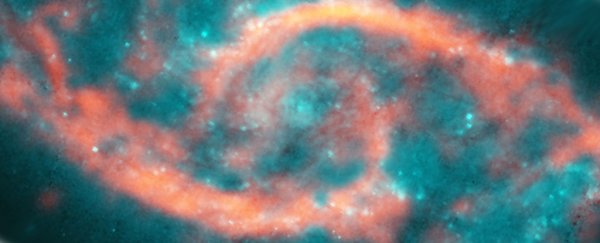The repercussions of two galaxies colliding with one another have generated a bizarre cosmic phenomenon – swirling arcs of star formation that seemingly resemble a human eye.
The optical illusion is the result of a spiral galaxy called IC 2163 'sideswiping' another spiral galaxy known as NGC 2207, and while these kinds of interactions are known to happen, it's extremely rare for them to end up looking like this.
"Although galaxy collisions of this type are not uncommon, only a few galaxies with eye-like, or ocular, structures are known to exist," says astronomer Michele Kaufman, who observed the phenomenon while a researcher at Ohio State University.
Kaufman's team discovered the eye-like structure – located about 114 million light-years from Earth in the direction of the constellation Canis Major – using the Atacama Large Millimetre/submillimetre Array (ALMA) in Chile.
 M. Kaufman; B. Saxton (NRAO/AUI/NSF); ALMA (ESO/NAOJ/NRAO); NASA/ESA Hubble Space Telescope
M. Kaufman; B. Saxton (NRAO/AUI/NSF); ALMA (ESO/NAOJ/NRAO); NASA/ESA Hubble Space Telescope
The scientists think that the shape and position of the orange arcs – which are made up of traces of gas detected by ALMA – are due to the outer spiral arms of IC 2163 and NGC 2207 scraping one another.
It's likely that this initial scraping is actually just the first step of an eventual merger between the two galaxies. This wouldn't ultimately happen for a long time, although the researchers count themselves lucky to have observed the ocular apparition while it still holds.
"Galactic eyelids last only a few tens of millions of years, which is incredibly brief in the lifespan of a galaxy," says Kaufman. "Finding one in such a newly formed state gives us an exceptional opportunity to study what happens when one galaxy grazes another."
The orange gas arcs are formed from traces of carbon monoxide, which is one of the fuels of star formation. The researchers say this gas in the outer eyelids is racing inwards to IC 2163's spiral centre at speeds greater than 100 kilometres per second (62 miles per second).
But the closer it gets, the more it slows down, eventually aligning itself with the rotation of the galaxy.
"Not only do we find a rapid deceleration of the gas as it moves from the outer to the inner edge of the eyelids, but we also measure that the more rapidly it decelerates, the denser the molecular gas becomes," says Kaufman.
"This direct measurement of compression shows how the encounter between the two galaxies drives gas to pile up, spawn new star clusters and form these dazzling eyelid features."
In the image below, you can see the eye in a broader context, with IC 2163 on the left, and the furthest reaches of its upper eyelid still interacting with NGC 2207's own gas arcs, on the right.
 M. Kaufman; B. Saxton (NRAO/AUI/NSF); ALMA (ESO/NAOJ/NRAO); NASA/ESA Hubble Space Telescope
M. Kaufman; B. Saxton (NRAO/AUI/NSF); ALMA (ESO/NAOJ/NRAO); NASA/ESA Hubble Space Telescope
Behind the carbon monoxide trails revealed by ALMA, the blue imagery is visible light as observed by the Hubble telescope.
Scientists think these kinds of collisions between galaxies would have been more common when the Universe was young, when such star systems existed in closer proximity with one another.
But back then, it's probable that eye-like formations were even more rare, as galactic disks would have been denser and more irregular in formation, meaning ocular structures would have been less likely to take shape like this.
In any case, seeing the eye in the sky now is definitely striking, and the fact that it backs up our understanding of how these spiral gas clouds move in space means it's a win-win for science and spectacle.
"This evidence for a strong shock in the eyelids is terrific," says astrophysicist Curtis Struck from Iowa State University.
"It's all very well to have a theory and simulations suggesting it should be true, but real observational evidence is great."
The findings are published in The Astrophysical Journal.
Image credit: M. Kaufman; B. Saxton (NRAO/AUI/NSF); ALMA (ESO/NAOJ/NRAO); NASA/ESA Hubble Space Telescope
